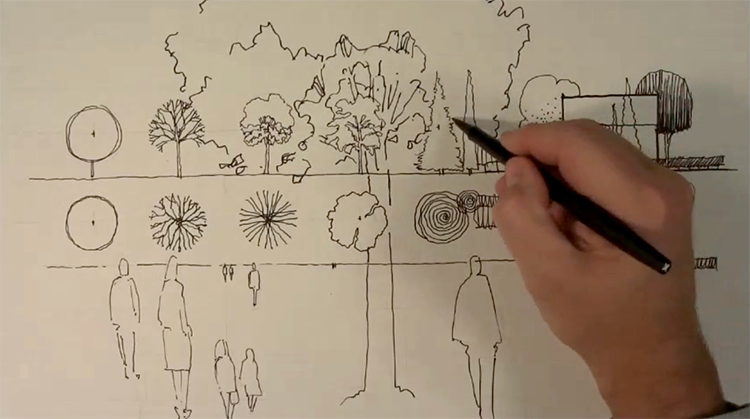“…the enjoyment of scenery employs the mind without fatigue and yet exercises it, tranquilizes it, and yet enlivens it; and thus through the influence of the mind over the body, gives the effect of refreshing rest and reinvigoration to the whole system”. Frederick Law Olmsted, 1865
A park is a place of biodiversity, where flora and fauna bring humans and nonhumans together. It is a space of nature. Parks are places of and for nature in a city, and parks preserve nature outside of cities. Earth presented itself as an endless park with immense oceans. People arrived on Earth, and as their populations increased, they built their environments apart from the natural world. Parks are places where people reintroduce nature into cities or preserve nature inside and outside of urban environments. Parks offer areas to sit, picnic on the grass, take a nap, play a game, and watch people, as well as enjoy the plants and trees, whether in close-up or long views, in sun or shaded landscapes. Most people would agree that parks offer us a moment to breathe, to be outside in nature, to enjoy the air, and to relax. Parks offer public areas to explore. Recreational parks provide activities such as strolling, hiking, walking, and cycling. In the 21st century, people recognize that diverse green spaces are crucial to their health and the well-being of the city.
Activity 2 – Remarkable Parks Around the World
Activity 3 – State Parks
Activity 4 – National Parks
The first National Park in the United States was established in 1872 at Yellowstone to preserve natural systems and landscapes.
Activity 5 – Fun Parks
Activity 6 – Sports Parks
Activity 7 – Parks as Art
Activity 8 – Landscape Parks
Review
Explore
- 10 Best Parks in Atlanta
- 2030 Pallette Global Parks
- All National Parks
- American Society of Landscape Architects
- Andre de Notre, Father of French Landscape Architecture
- Arthur Casas Praca Da Se, Brazil
- ASLA Revitalizing Communities with Parks
- Atlanta's Linear Olmsted Parks
- A Wealth of Nature
- Beijing, China Parks
- Boston Commons USA's Oldest Park
- Buffalo Parks Olmsted Lefacy
- Capability Brown Gardens
- Capability Brown, UK Gardener and Landscape Designer
- Capital Grounds, Washington DC, by Olmsted
- Chicago Park District
- Chicago Parks
- City Parks Alliance
- Elmerald Necklace Conservatory
- Find A Park
- Find a Park Milwaukee
- Find a State Park
- Five Seasons: The Gardens of Piet Oudolf Trailer
- Fort Wayne Parks
- Frederick Law Olmstead, Father of American Landscape Architecture
- Greater London National park map
- History of US National Parks
- LANDWORKS STUDIO
- London Green Roofs, Green Spaces, Forests
- London Parks Interactive Map
- Marie de Medici's Tuilleries Gardens Paris & Le Notre
- Milwaukee County Parks
- National Parks China
- New York City Parks
- NYC Central Park
- Oldest Parks in the World
- Olmstead Atlanta Park
- Olmstead Parks Louisville
- Olmsted 200
- Olmsted's Lake Park Milwaukee
- Open Outdoors for Kids
- Parc de Bercy Paris
- Parc de La Villette Paris by Bernard Tschumi
- Paris Green Spaces Map
- Paris Park Bercy
- Paris Park Citroen, Paris, Patrick Berger, Gils Clement Landscape Architects
- Paris Park La Villette Bernard Tschumi Architect
- Paris Parks
- Park Guell and Other Barcelona Parks
- ParkScore Jacksonville FLA
- Plitvice Lakes National Park, Croatia
- Pocket Parks and why they matter
- Pollinator Gardens.pdf
- Roberto Burel Marx Reimagining Parks Retrospective
- Roberto Burle Marx Brazilian Landscape Architect of Parks
- Royal Parks of London
- San Francisco Parks Public Accessibility Score
- SITE Design Group
- The TRUST for PUBLIC LANDS: Turning School yards into Community Parks
- Thomas Little Plant Whisperer UrbanGreenGardens
- Top 10 National Parks India
- Tuileries Garden Paris
- TUILLERIES GARDENS Paris
- Ueno Park, Tokyo, Japan
- UNESCO Biosphere Reserve Parks
- Urban Parks In America
- US National Parks
- Video Frederick Law Olmstead Designing America
- Video PARKING
- Walter Hood
- What is a park?
Relate
- Electric Light
- Ergonomics
- Experience Design
- Forests
- Grass
- Green Cities
- Green Roofs
- Green Streets
- Growing food
- Historic Preservation
- Lakes
- Nature Play
- Pavilions
- Playscapes
- Pocket Parks
- Public Space
- Rain Gardens
- Rivers
- School Gardens
- Site Analysis
- Site Programming
- Smart Cities
- Smart Grid
- Soil
- Soundscapes
- Streets
- Sunlight
- Tree Identification
- Urban Design
- Water
- Watershed
- Well Being



















































